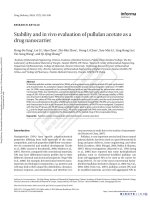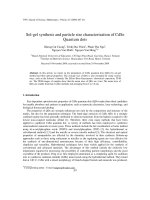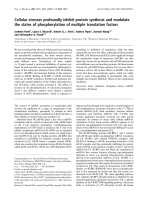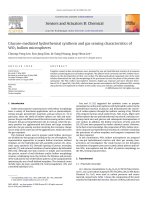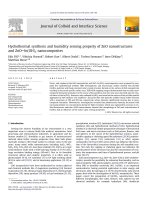Synthesis and acute toxicity evaluation of Hantzsch 1,4-dihydropyridine derivatives
Bạn đang xem bản rút gọn của tài liệu. Xem và tải ngay bản đầy đủ của tài liệu tại đây (238.06 KB, 4 trang )
<span class='text_page_counter'>(1)</span><div class='page_container' data-page=1>
<i>Can Tho University Journal of Science </i> <i>Vol. 54, No. 5 (2018): 77-80 </i>
77
<i>DOI: 10.22144/ctu.jen.2018.028 </i>
<b>Synthesis and acute toxicity evaluation of Hantzsch 1,4-dihydropyridine derivatives </b>
Huynh Nhu, Tran Hoang Yen and Nguyen Thi Thu Tram*<sub> </sub>
<i>Can Tho University of Medicine and Pharmacy, Vietnam </i>
<i>*<sub>Correspondence: Nguyen Thi Thu Tram (email: ) </sub></i>
<b>Article info. </b> <b> ABSTRACT </b>
<i>Received 10 Oct 2017 </i>
<i>Revised 02 Feb 2018 </i>
<i>Accepted 20 Jul 2018</i>
<i><b> The derivatives of 1,4-dihydropyridines are well known as calcium channel </b></i>
<i>modulators for the treatment of cardiovascular disorders. Herein, three </i>
<i>1,4-dihydropyridines were synthesized through the condensation of an </i>
<i>al-dehyde, a β-ketoester, and ammonium acetate in ethanol with yields </i>
<i>rang-ing from 23 to 59%. Their structures were confirmed by comparison HRMS, </i>
<i>NMR spectral data with the literature. The acute oral toxicity study for the </i>
<i>synthesized compounds revealed that all compounds were safe up to 2,000 </i>
<i>mg/kg, and no deaths of animals were recorded. </i>
<i><b>Keywords </b></i>
<i>1,4-dihydropyridines, acute </i>
<i>toxicity, Hantzsch ester, </i>
<i>β-ke-toester </i>
Cited as: Nhu, H., Yen, T.H. and Tram, N.T.T., 2018. Synthesis and acute toxicity evaluation of Hantzsch
<i>1,4-dihydropyridine derivatives. Can Tho University Journal of Science. 54(5): 77-80. </i>
<b>1 INTRODUCTION </b>
Described more than one century ago by Hantzsch,
1,4-dihydropyridines (1,4-DHPs) have now been
recognized as effective drugs for the treatment of
angina and hypertension (Eynde and Mayence,
2003). Some 1,4-DHPs drugs are commercialized as
Amlodipine, Felodipine, Isradipine, Lacidipine,
Nicardipine, Nifedipine, Nimodipine and
Nitrendipine. Due to their capacity to bind to
calcium channels and consequently decrease the
transmembrane calcium current, associated in
smooth muscle, their effects result in long-lasting
relaxation and in a reduction of contractility
<i>throughout the heart (Love et al.,1974; Bossert et </i>
<i>al., 1981). The original Hantzsch dihydropyridine </i>
synthesis consists of a multicomponent reaction of
acetoacetate esters with aldehyde-ammonia
(Hantzsch, 1881). To perform this condensation, the
reaction mixture is usually refluxed for several
hours (> 10 hrs.). Herein, a simple 1,4-DHPs
synthetic method with improving reaction time was
reported. The acute toxicity of the three synthesized
1,4-DHPs (Figure 1) was then evaluated. The results
provided important information in search for
potential pharmacologically active drugs.
N
H CH3
H3C
COOCH3
H3COOC
2
3
5
6
4
7
8
9
10
11
12
1
N
H CH3
H3C
COOCH<sub>3</sub>
H<sub>3</sub>COOC
2
3
5
6
4
1'
2'
3'
4'
5'
6'
7
8
9
10
11
12
1
18
17
16
15
14
13
N
H CH3
H<sub>3</sub>C
COOC
COOC
2
3
5
6
4
7
8
9
10
11
12
1
CH3
CH3
CH3
H3C
H3C
H3C
<b>1</b> <b><sub>2</sub></b> <b><sub>3</sub></b>
</div>
<span class='text_page_counter'>(2)</span><div class='page_container' data-page=2>
<i>Can Tho University Journal of Science </i> <i>Vol. 54, No. 5 (2018): 77-80 </i>
78
<b>2 EXPERIMENTS </b>
<b>2.1 General experimental procedures </b>
The NMR experiments were performed on a Bruker
DMX 300 spectrometer. Proton chemical shifts
were reported in parts per million (ppm) from
tetramethylsilane (TMS). ESI-HRMS was carried
out on a MICROMASS ZabspecTOF spectrometer
for electrospray ionization. Melting point was
recorded on a Krüss Melting Point Meters M5000.
Thin layer chromatography was performed on
Kieselgel 60F254 plates (Merck), and spots were
visualized under UV light or sprayed with vanillin
(0.5 g vanillin in 80 mL sulfuric acid and 20 mL
ethanol), then heated. All solvents used were
purchased from Chemsol, purity ≥ 99.0 %.
<b>2.2 Synthesis of 1,4-dihydropyridine </b>
<b>derivatives </b>
The three synthesized 1,4-DHPs were performed
through Hantzsch reaction (Hantzsch, 1881) with
some detailed modifications.
<b>Dimethyl </b>
<b>2,6-dimethyl-1,4-dihydropyridin-3,5-dicarboxylate </b> <b>(1): </b> a mixture of
hexamethylenetetramine (560 mg, 5 mmol), methyl
acetoacetate (1,160 mg, 10 mmol), ammonium
acetate (539 mg, 7 mmol) and ethanol (1 mL) was
heated in a 100 mL flask at 80°C for 20 minutes with
magnetic stirrer.
<b>Dimethyl </b> <b></b>
<b>2,6-dimethyl-4-phenyl-1,4-dihydropyridin-3,5-dicarboxylate (2): a mixture </b>
of benzaldehyde (530 mg, 5 mmol), methyl
acetoacetate (1,160 mg, 10 mmol), ammonium
acetate (539 mg, 7 mmol) and ethanol (1 mL) was
heated in a 100 mL flask at 80°C for 20 minutes with
magnetic stirrer.
<i><b>Di-tert-butyl </b></i>
<b>2,6-dimethyl-1,4-dihydropyridin-3,5-dicarboxylate </b> <b>(3): </b> a mixture of
<i>hexamethylenetetramine (560 mg, 5 mmol), </i>
tert-butyl acetoacetate(1,520 mg, 10 mmol), ammonium
acetate (539 mg, 7 mmol) and ethanol (1 mL) was
heated in a 100 mL flask at 80°C for 20 minutes with
magnetic stirrer.
After cooling, the products were precipitated as
yellow crystals which were collected by filtration.
Recrystallization from ethanol gave pure products.
<b>Compound (1): yield 59%; yellow powder; R</b><i>f</i> = 0.54
(chloroform:ethyl acetate 85:15); M.p 227°C; 1<sub>H </sub>
NMR (300 MHz, CDCl3<i>): δ</i>H ppm <i>5.20 (s, 1H, NH); </i>
<i>3.24 (m, 2H, H4); 3.68 (s, 6H, OCH</i>3<i>×2); 2.17 (s, </i>
6H, CH3×2); 13C NMR (75 MHz, CDCl3<i>): δ</i>C ppm
168.6 (C10, C11); 145.3 (C2, C6); 99.5 (C3, C5);
51.2 (C9,C12); 25.0 (C4); 19.3 (C7, C8). HRMS
(ESI+<i><sub>): m/z calcd for C</sub></i><sub>11</sub><sub>H</sub><sub>16</sub><sub>NO</sub><sub>4</sub><sub> [M+H]</sub>+<sub> 225.1079; </sub>
found 225.1085.
<b>Compound (2): yield 23%; white powder; R</b><i>f</i> = 0.64
(chloroform:ethyl acetate 85:15); M.p 199°C; 1<sub>H </sub>
NMR (300 MHz, CDCl3<i>): δ</i>H ppm <i>7.23 (m, 5H, </i>
H2-H6); 5.80 (m, 1H, H4); 5.03 (s, 1H, NH); 3.66 (s,
6H, OCH3<i>×2), 2.35 (s, 6H, CH</i>3×2); 13C NMR
(75MHz, CDCl3<i>): δ</i>C ppm 168.2 (C10, C11); 147.5
(C1); 144.4 (C2, C6); 128.1 (C3, C5); 127.7 (C2,
C6); 126.3 (C4); 103.9 (C3, C5); 51.1 (C9, C12);
39.4 (C4); 19.7 (C7, C8). HRMS (ESI+<i><sub>): m/z calcd </sub></i>
for C17H19NO4 [M+H]+ 301.1314; found 301.1327.
<b>Compound (3): yield 55%; pale yellow powder; R</b><i>f</i>
= 0.72 (chloroform:ethyl acetate 85:15); M.p
137°C; 1<sub>H NMR (300 MHz, CDCl</sub><sub>3</sub><i><sub>): δ</sub></i><sub>H ppm </sub><i><sub>5.16 (s, </sub></i>
<i>1H, NH), 3.13 (m, 2H, H4), 2.11 (s, 6H, CH</i>3×2),
<i>1.44 (s, 18H, CH</i>3×6); 13C NMR (75 MHz, CDCl3):
<i>δ</i>C ppm 167.8 (C10, C11); 144.0 (C2, C6); 100.9 (C3,
C5); 79.6 (C9, C12); 28.5 (C13-C18); 25.6 (C4);
19.4 (C7, C8). HRMS (ESI+<i><sub>): m/z calcd for </sub></i>
C17H28NO4 [M+H]+ 310.2018; found 310.2021.
<b>2.3 Acute toxicity study </b>
<b>The acute oral toxicity study for compounds 1, 2 and </b>
<b>3 was carried out by following the Organisation for </b>
Economic Co-operation and Development (OECD)
<i>guidelines (Vijesh et al., 2011) and the lethal dose </i>
50 (LD50) was determined by Litchfield-Wilcoxon
<i>method (Litchfield et al.,1949). The male and </i>
female mice weighing 18-22 g were used for the
evaluation. The experiments were performed in
stable conditions such as the light of 100 ± 5 lux, the
temperature of 27 ± 1o<sub>C and the minimized noise. </sub>
Each group consisted of 6 mice. Different doses
from 100 to 2,000 mg/kg (100 mg/kg, 200 mg/kg,
400 mg/kg, 800 mg/kg, 1,000 mg/kg and 2,000
mg/kg) were selected and administered orally as a
single dose as fine suspension prepared in double
distilled water using Tween 80. The acute toxic
symptoms, the behavioral changes and the death
percentage of each group produced by the test
compounds were observed and recorded
continuously after the first 30 minutes, during the
first 24 hours, and daily thereafter for a total of 14
experiment days.
<b>3 RESULTS AND DISCUSSION </b>
</div>
<span class='text_page_counter'>(3)</span><div class='page_container' data-page=3>
<i>Can Tho University Journal of Science </i> <i>Vol. 54, No. 5 (2018): 77-80 </i>
79
with time and energy efficiency as well as with
simple purification steps. The pure products were
obtained in yield from 23 to 59%. The low yield
<b>obtained in the case of 2 could be explained by steric </b>
hindrance of aromatic moiety of benzaldehyde
group. In this study, hexamethylenetetramine was
used as the source of the ammonia-formaldehyde
mixture. Ammonium acetate (7 mmol) was added to
the reaction medium in order to obtain the
stoichiometric balance between ammonia and
<b>formaldehyde. Compounds 1 and 3 have been </b>
previously reported to be synthesized by
multi-component condensation reaction of
hexamethylenetetramine, acetoacetate ester, and
<i>ammonium acetate in excess of solvent (Uldrikis et </i>
<i>al., 1975) or under microwave irradiation (Torchy et </i>
<i>al., 2002) or ultrasonic irradiation with catalyst </i>
(Kumar and Maurya, 2008). Here, such compounds
were synthesized with similar yields but under mild
conditions, short reaction time and solvent quantity
decrease (Figure 2). Their structures were
elucidated by spectroscopic data and compared with
<i>those in references (Koukabi et al., 2012; Ferraro et </i>
<i>al., 2016; Zhang et al., 2017).</i>
<b>Fig. 2: Synthesis of compounds 1 and 3 </b>
The experimental toxicity results showed that no
deaths of animals were recorded when orally using
the certain increasing doses from 100 mg/kg to
2,000 mg/kg after different time of 30 minutes, 24
hours and up to 72 hours, and the dose of 2,000
mg/kg was the largest dose of each synthesized
<b>1,4-DHP (1, 2 and 3) that could be prepared as the stably </b>
oral suspension and orally administered. Moreover,
no significant behavioral changes were observed in
tested mice during 14 days.
<b>4 CONCLUSIONS </b>
In summary, a rapid and efficient condensation for
the synthesis of 1,4-DHPs in moderate to reasonable
yields was described. No acute toxicity was
observed at the maximum dose of 2,000 mg/kg. The
results provide useful information for further
pharmacological study on such derivatives for the
<b>development of new agents. </b>
<b>ACKNOWLEDGMENTS </b>
We are grateful to Dr. Nguyen Thanh Binh, Institut
de Chimie des Substances Naturelles, ICSN, CNRS,
France for valuable supports.
<b>REFERENCES </b>
Bossert, F., Meyer, H. and Wehinger, E., 1981.
4-Aryldihydropyridines, a new class of highly active
<i>calcium antagonists. Angewandte Chemie </i>
International Edition in English. 20(9): 762-769.
Eynde, J.J.V. and Mayence, A., 2003. Synthesis and
aromatization of Hantzsch 1,4-dihydropyridines
under microwave irradiation. An overview.
Molecules. 8(4): 381-391.
Ferraro, A., Bernardi, L. and Fochi, M., 2016.
Organocatalytic enantioselective transfer
hydrogenation of β-Amino Nitroolefins. Advanced
Synthesis and Catalysis. 358(10): 1561-1565.
Hantzsch, A., 1881. Condensationprodukte aus
Aldehydammoniak und ketoniartigen Verbindungen.
European Journal of Inorganic Chemistry. 14(2):
1637-1638.
Koukabi, N., Kolvari, E., Zolfigol, M.A., Khazaei, A.,
Shaghasemi, B.S. and Fasahati, B., 2012. A magnetic
particle-supported sulfonic acid catalyst: Tuning
catalytic activity between homogeneous and
heterogeneous catalysis. Advanced Synthesis and
Catalysis. 354(10): 2001-2008.
Kumar, A. and Maurya, R.A., 2008. Efficient synthesis
of Hantzsch esters and polyhydroquinoline
</div>
<span class='text_page_counter'>(4)</span><div class='page_container' data-page=4>
<i>Can Tho University Journal of Science </i> <i>Vol. 54, No. 5 (2018): 77-80 </i>
80
Litchfield, J.A., and Wilcoxon, F., 1949. A simplified
method of evaluating dose-effect experiments.
Journal of Pharmacology and Experimental
therapeutics. 96(2): 99-113.
Love, B., Goodman, M., Snader, K., Tedeschi, R. and
Macko, E., 1974. “Hantzsch-type” dihydropyridine
<i>hypotensive agents. Journal of medicinal chemistry. </i>
17(9): 956-965.
Torchy, S., Cordonnier, G., Barbry, D., and Vanden
Eynde, J.J., 2002. Hydrogen transfer from Hantzsch
1,4-dihydropyridines to carbon-carbon double bonds
under microwave irradiation. Molecules. 7(7):
528-533.
Uldrikis, Y.R., Dubur, G.Y., Dipan, I.V. and
Chekavichus, B.S., 1975. Synthesis and oxidation of
2,6-dimethyl-1,4- dihydropyridine-3,5-dicarboxylic
acid esters. Chemistry of Heterocyclic Compounds.
11(9): 1070-1076.
Vijesh, A.M., Isloor, A.M., Peethambar, S.K.,
Shivananda, K.N., Arulmoli, T. and Isloor, N.A.,
2011. Hantzsch reaction: synthesis and
characterization of some new 1,4-dihydropyridine
derivatives as potent antimicrobial and antioxidant
agents. European journal of medicinal chemistry.
46(11): 5591-5597.
Zhang, J., Li, Y., Xu, R. and Chen, Y., 2017. Donor–
acceptor complex enables alkoxyl radical generation
for metal-free C(sp3<sub>)–C(sp</sub>3<sub>) cleavage and </sub>
</div>
<!--links-->
